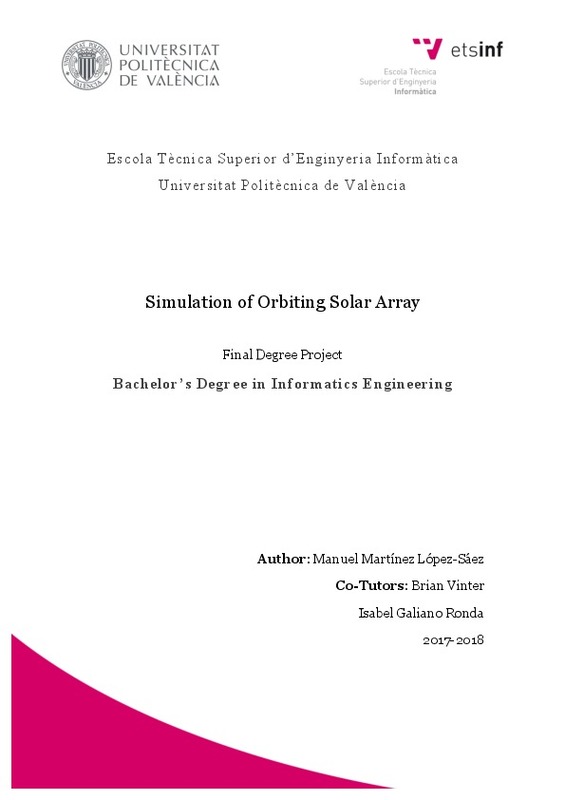JavaScript is disabled for your browser. Some features of this site may not work without it.
Buscar en RiuNet
Listar
Mi cuenta
Estadísticas
Ayuda RiuNet
Admin. UPV
Simulation of Orbiting Solar Array
Mostrar el registro sencillo del ítem
Ficheros en el ítem
| dc.contributor.advisor | Galiano Ronda, Isabel Remedios
|
es_ES |
| dc.contributor.advisor | Vinter, Brian
|
es_ES |
| dc.contributor.author | Martínez López Sáez, Manuel
|
es_ES |
| dc.date.accessioned | 2018-09-06T07:23:22Z | |
| dc.date.available | 2018-09-06T07:23:22Z | |
| dc.date.created | 2018-06-26 | |
| dc.date.issued | 2018-09-06 | es_ES |
| dc.identifier.uri | http://hdl.handle.net/10251/106674 | |
| dc.description.abstract | [EN] Web application to be used by high school students as a teaching tool to better understand complex newtonian physics such as orbital dynamics and the effects these have on satellites. Simulation to b e run on the amount of energy received from the Sun while on orbit for one orbital period and the gravitational interaction between bodies in the simulation. Students will be able to manipulate the amount of solar panels (surface area) on the satellite in order to have a cubesat capable of operating on orbit without losing power. Changing the orbit will therefore affect the outcome of this simulation. Complex calculations to be carried out in server side and then shown graphically with client side of the application. Application will be interactive and thus allow users to manipulate different elements on screen. Users will also be challenged with different objectives with the outcome of learning the effects and math behind these calculations and simulations. | es_ES |
| dc.description.abstract | [ES] Aplicación web para ser utilizada por estudiantes de secundaria como una herramienta de enseñanza para comprender mejor la física newtoniana, por ejemplo, la dinámica orbital y los efectos que estos tienen sobre los satélites. Simulación para calcular la cantidad de energía solarrecibida en órbita durante un período orbital y la interacción gravitacional entre los cuerpos en la simulación. Los estudiantes podrán manipular la cantidad de paneles solares (área de superficie) en el satélite para tener un satelite capaz de operar en órbita sin perder potencia. Por lo tanto, cambiar la órbita afectará el resultado de esta simulación. Los cálculos complejos se llevarán a cabo en el lado del servidor y luego se mostrarán gráficamente en el lado del cliente de la aplicación. La aplicación será interactiva y, por lo tanto, permitirá a los usuarios manipular diferentes elementos en la pantalla. Los usuarios también serán desafiados con diferentes objetivos con el resultado de aprender los efectos y matemática detrás de estos cálculos y simulaciones. | es_ES |
| dc.format.extent | 57 | es_ES |
| dc.language | Inglés | es_ES |
| dc.publisher | Universitat Politècnica de València | es_ES |
| dc.rights | Reserva de todos los derechos | es_ES |
| dc.subject | Space | es_ES |
| dc.subject | Satellites | es_ES |
| dc.subject | Orbit | es_ES |
| dc.subject | Interactive | es_ES |
| dc.subject | Python | es_ES |
| dc.subject | Energy | es_ES |
| dc.subject | Solar | es_ES |
| dc.subject | Espacio | es_ES |
| dc.subject | Satelites | es_ES |
| dc.subject | Física | es_ES |
| dc.subject.classification | LENGUAJES Y SISTEMAS INFORMATICOS | es_ES |
| dc.subject.other | Grado en Ingeniería Informática-Grau en Enginyeria Informàtica | es_ES |
| dc.title | Simulation of Orbiting Solar Array | es_ES |
| dc.title.alternative | Simulación de panel solar en órbita | es_ES |
| dc.type | Proyecto/Trabajo fin de carrera/grado | es_ES |
| dc.rights.accessRights | Abierto | es_ES |
| dc.contributor.affiliation | Universitat Politècnica de València. Departamento de Sistemas Informáticos y Computación - Departament de Sistemes Informàtics i Computació | es_ES |
| dc.contributor.affiliation | Universitat Politècnica de València. Escola Tècnica Superior d'Enginyeria Informàtica | es_ES |
| dc.description.bibliographicCitation | Martínez López Sáez, M. (2018). Simulation of Orbiting Solar Array. http://hdl.handle.net/10251/106674 | es_ES |
| dc.description.accrualMethod | TFGM | es_ES |
| dc.relation.pasarela | TFGM\88353 | es_ES |
Este ítem aparece en la(s) siguiente(s) colección(ones)
-
ETSINF - Trabajos académicos [5160]
Escola Tècnica Superior d'Enginyeria Informàtica






